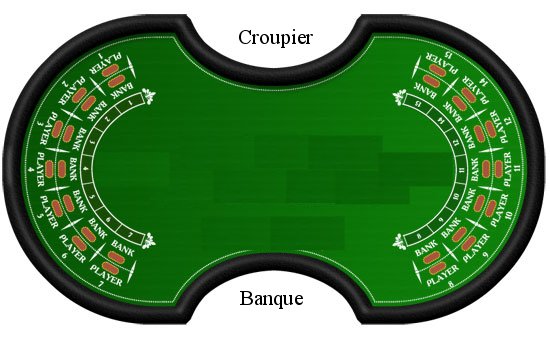|
Baccarat is the
mother name for a collection of games with very similiar rules but its origins
are not clear as many card game historians compete with their own derivations
of the game.
The oldest variation still in play is Baccarat en Banque
(often referred to simple as Baccarat Banque) which is also known as Baccarat
Deux Tables. Baccarat Punto Banco is a
popular casino house run version of this and Baccarat Chemin de Fer is a
non-house run version popular in the mid-20th century and made famous by James
Bond. This page deals with Baccarat en Banque. Confusion arises with many
casinos around the world dealing Baccarat Punto Banco and calling it simply
Baccarat. Baccarat en Banque is rarely played even in European
casinos. Baccarat en Banque
The Table
Baccarat en Banque is played on
cello shaped table, that is an oval with two side cut-outs in the middle and in
really old games just one cut-out. The player owning the bank sits in one of
the cut-outs and a croupier sits opposite. The two ends of the table can seat
five players each. Similar to the image but without the modern
markings.

Electing the Banque
One of the
players has to become the Banque. There are two traditional ways of choosing
who that is. The main and obvious way is the individual players post an amount
of money in front of them. The largest bet means that player becomes the Banque
and the amount is the maximum they can lose on any hand. If the Banque chooses
to do so then they can cover any extra bets.
Shuffle and
Deal
Unusually Baccarat en Banque uses three 52 card
decks. Chemin de Fer (known as Chemmy) uses six decks and Punto Banco uses
eight. The croupier shuffles the shoe of cards and then offers it to the
players on either side to shuffle again. They can decline but in any case the
shoe moves to the Banque for one last shuffle.
The Banque is the dealer
in this game and they begin by dealing a face down card to the player's hand on
their right, then the player's hand on their left, then one to themselves, and
then repeats the same deal. There are now three 2 card hands, one for the
players on the right, one for the players on the left and one for the dealer.
So the bank is playing their hand against two player hands. This is where the
alternative name Baccarat Deux Tables comes from.
Betting and
Play Options
The group of players on each side of the
table are nominally playing the hand on their side. However the players can bet
on the near hand, the far hand or both at once. The croupier is there to assist
players placing the bet in the correct place. A box further away from them
allows the placement of a bet on the other side's hand and playing both is said
to be playing 'across the line', and the croupier will place the bet on a
stripe running between croupier and banker.
When making bets the player
on the dealer's right has first option and then dealer's left. It alternates
from side to side in order. Any player can say 'Go Bank' when it is their turn
which means match the banker's entire stake. Only one person can do this per
hand. As there are two player's hands someone on the other side can do the same
and then their bets are halved.
When a player takes on the bank and
loses, they get two more chances to win back their share. If they lose both
those challenges, they cannot go bank again for the remainder of the game.
The exact policy for wagering limits can depend on either the banker or
the house rules. In most cases, the total table limit is equal to the
banker’s bet; so if the bank stakes £1000, the combined amount of
player bets cannot exceed that amount. However, the banque may decide to cover
any surplus bets on the table, in which case they are obliged to do so for
every hand thereafter. Otherwise, the croupier will remove any excess wagers in
reverse playing order (i.e. the last bet is returned
first).
Player Drawing Rules
The players immediately left and
right of the banker represent their respective halves of the table. They hold
this position as long as they keep winning; as soon as they lose their hand,
the honour passes to the next person in the playing order.Technically speaking,
the player controlling the hand can do whatever he or she likes on a total of
seven or less. With the rest of the table’s money on the line, however, it
is considered very bad form to stray from traditional drawing norms.
Right of the bank
acts first, then the left, then the banker. If the hand is a natural eight or
nine, the punter reveals the cards and wins immediately unless the banque has
an equal or greater score. Otherwise;
- If the score is six or seven points then take
no more cards
- If the score is four or less, take a third
and final card
- If the score is five, you can choose whether
or not to take another card
Players should look
to vary their decisions on five to make it harder for the
Banker.
Banker Drawing Rules
The bank
must declare a natural immediately, just like the players, but otherwise there
are no set laws regarding when to stand or draw. As the dealer only has their
own cash to consider, there’s much less pressure to adhere to standard
drawing rules but they are generally best. |
